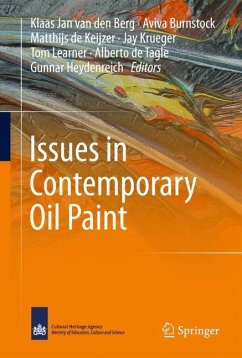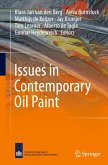Issues in Contemporary Oil Paint
Herausgegeben:Burnstock, Aviva; de Keijzer, Matthijs; Krueger, Jay; Learner, Tom; de Tagle, Alberto; Heydenreich, Gunnar; van den Berg, Klaas Jan
Issues in Contemporary Oil Paint
Herausgegeben:Burnstock, Aviva; de Keijzer, Matthijs; Krueger, Jay; Learner, Tom; de Tagle, Alberto; Heydenreich, Gunnar; van den Berg, Klaas Jan
- Gebundenes Buch
- Merkliste
- Auf die Merkliste
- Bewerten Bewerten
- Teilen
- Produkt teilen
- Produkterinnerung
- Produkterinnerung
This volume represents 27 peer-reviewed papers presented at the ICOP 2013 symposium which will help conservators and curators recognise problems and interpret visual changes on paintings, which in turn give a more solid basis for decisions on the treatment of these paintings. The subject matter ranges from developments of paint technology, working methods of individual artists, through characterisation of paints and paint surfaces, paint degradation vs. long time stability, to observations of issues in collections, cleaning and other treatment issues as well as new conservation approaches.
Andere Kunden interessierten sich auch für
![Issues in Contemporary Oil Paint Issues in Contemporary Oil Paint]() Issues in Contemporary Oil Paint97,99 €
Issues in Contemporary Oil Paint97,99 €![THz Technology Applied to Cultural Heritage in Practice THz Technology Applied to Cultural Heritage in Practice]() Kaori FukunagaTHz Technology Applied to Cultural Heritage in Practice75,99 €
Kaori FukunagaTHz Technology Applied to Cultural Heritage in Practice75,99 €![Transmission Electron Microscopy Transmission Electron Microscopy]() Transmission Electron Microscopy91,99 €
Transmission Electron Microscopy91,99 €![In-situ Materials Characterization In-situ Materials Characterization]() In-situ Materials Characterization75,99 €
In-situ Materials Characterization75,99 €![Atom Probe Microscopy Atom Probe Microscopy]() Baptiste GaultAtom Probe Microscopy186,99 €
Baptiste GaultAtom Probe Microscopy186,99 €![Managing Indoor Climate Risks in Museums Managing Indoor Climate Risks in Museums]() Bart AnkersmitManaging Indoor Climate Risks in Museums160,49 €
Bart AnkersmitManaging Indoor Climate Risks in Museums160,49 €![The Iron Pnictide Superconductors The Iron Pnictide Superconductors]() The Iron Pnictide Superconductors82,99 €
The Iron Pnictide Superconductors82,99 €-
-
-
This volume represents 27 peer-reviewed papers presented at the ICOP 2013 symposium which will help conservators and curators recognise problems and interpret visual changes on paintings, which in turn give a more solid basis for decisions on the treatment of these paintings. The subject matter ranges from developments of paint technology, working methods of individual artists, through characterisation of paints and paint surfaces, paint degradation vs. long time stability, to observations of issues in collections, cleaning and other treatment issues as well as new conservation approaches.
Produktdetails
- Produktdetails
- Verlag: Springer / Springer International Publishing / Springer, Berlin
- Artikelnr. des Verlages: 86309432, 978-3-319-10099-9
- 2014
- Seitenzahl: 448
- Erscheinungstermin: 18. November 2014
- Englisch
- Abmessung: 241mm x 160mm x 30mm
- Gewicht: 867g
- ISBN-13: 9783319100999
- ISBN-10: 3319100998
- Artikelnr.: 41156062
- Herstellerkennzeichnung Die Herstellerinformationen sind derzeit nicht verfügbar.
- Verlag: Springer / Springer International Publishing / Springer, Berlin
- Artikelnr. des Verlages: 86309432, 978-3-319-10099-9
- 2014
- Seitenzahl: 448
- Erscheinungstermin: 18. November 2014
- Englisch
- Abmessung: 241mm x 160mm x 30mm
- Gewicht: 867g
- ISBN-13: 9783319100999
- ISBN-10: 3319100998
- Artikelnr.: 41156062
- Herstellerkennzeichnung Die Herstellerinformationen sind derzeit nicht verfügbar.
Klaas Jan van den Berg Institute for Cultural Heritage, Netherlands (and Institute of the Dutch Ministry of Education, Culture and Science).
From the content: 1. 20th Century Oil Paint. The interface between science and conservation and the challenges for modern oil paint research .- 2. Do we see what we know or do we know what we see? Conservation of oil paintings in the Stedelijk Museum Amsterdam.- 3. Towards interpretation of making, meaning, and change in British 20th century oil paintings: the relevance of an artist's paint archive.- 4. The delight of modern organic pigment creations.- 5. Modern Oil Paints - Formulations, organic additives, and degradation: some case studies.- 6. Distinction by micro-Raman spectroscopy and chemometrical analysis of copper phthalocyanine blue polymorphs in oil-based and acrylic paint samples.- 7. Charting the development of oil-based enamel paints through the correlation of historical paint technology manuals with scientific analysis.- 8. Hans Hofmann's last lesson: a study of the artist's materials in the last decade of his career. 9. Théorème de Gödel by Georges Mathieu, 1957. Study and restoration: consolidation through cohesive regeneration using a solvent.- 10. Non-traditionally painted oil painting: how to treat it properly? Josip Vanista's Cakes (1955).- 11. Conservation Issues in Several 20th-Century Canadian Oil Paintings: The Role of Zinc Carboxylate Reaction Product.- 12. Zwei Jünglinge und Zwei Mädchen, a tempera painting by Otto Mueller, circa 1917. Paint analysis and reconstruction.- 13. Metal soaps and visual changes in a painting by René Magritte -The Menaced Assassin, 1927.- 14. Fleurs Grises - A delicate surface. Difficult to clean - Essential to protect.- 15. Derivatisation technique for infrared spectroscopy - Characterisation of oxidative ageing products in modern oil paint. 16. Investigating fluidizing dripping pink commercial paint on Van Hemert's Seven-series works from 1990-1995.- 17. Hard dry paint, softening tacky paint, and exuding drips on Composition (1952) by Jean-Paul Riopelle.- 18. Zinc white and the influence of paint composition forstability in oil based media.- 19. It's surreal: zinc-oxide degradation and misperceptions in Salvador Dalí's Couple with Clouds in their Heads, 1936.- 20. Water Sensitive Oil Paints in the 20th Century: A study of the distribution of water-soluble degradation products in modern oil paint films.- 21. An investigation into the viability of removal of lead soap efflorescence from contemporary oil paintings.- 22. Set back the race: Treatment strategies for running oil paint.- 23. Sensitivity of modern oil paints to solvents. Effects on synthetic organic pigments.- 24. Dry Cleaning: research and practice.- 25. New Approaches to Surface Cleaning of Unvarnished Contemporary Oil Paintings - Moist Sponges and Cloths.- 26. Agar - a new tool for the surface cleaning of water sensitive oil paint?.- 27. Investigation into the surface conductivity of water-sensitive modern oil paints.
From the content: 1. 20th Century Oil Paint. The interface between science and conservation and the challenges for modern oil paint research .- 2. Do we see what we know or do we know what we see? Conservation of oil paintings in the Stedelijk Museum Amsterdam.- 3. Towards interpretation of making, meaning, and change in British 20th century oil paintings: the relevance of an artist's paint archive.- 4. The delight of modern organic pigment creations.- 5. Modern Oil Paints - Formulations, organic additives, and degradation: some case studies.- 6. Distinction by micro-Raman spectroscopy and chemometrical analysis of copper phthalocyanine blue polymorphs in oil-based and acrylic paint samples.- 7. Charting the development of oil-based enamel paints through the correlation of historical paint technology manuals with scientific analysis.- 8. Hans Hofmann's last lesson: a study of the artist's materials in the last decade of his career. 9. Théorème de Gödel by Georges Mathieu, 1957. Study and restoration: consolidation through cohesive regeneration using a solvent.- 10. Non-traditionally painted oil painting: how to treat it properly? Josip Vanista's Cakes (1955).- 11. Conservation Issues in Several 20th-Century Canadian Oil Paintings: The Role of Zinc Carboxylate Reaction Product.- 12. Zwei Jünglinge und Zwei Mädchen, a tempera painting by Otto Mueller, circa 1917. Paint analysis and reconstruction.- 13. Metal soaps and visual changes in a painting by René Magritte -The Menaced Assassin, 1927.- 14. Fleurs Grises - A delicate surface. Difficult to clean - Essential to protect.- 15. Derivatisation technique for infrared spectroscopy - Characterisation of oxidative ageing products in modern oil paint. 16. Investigating fluidizing dripping pink commercial paint on Van Hemert's Seven-series works from 1990-1995.- 17. Hard dry paint, softening tacky paint, and exuding drips on Composition (1952) by Jean-Paul Riopelle.- 18. Zinc white and the influence of paint composition forstability in oil based media.- 19. It's surreal: zinc-oxide degradation and misperceptions in Salvador Dalí's Couple with Clouds in their Heads, 1936.- 20. Water Sensitive Oil Paints in the 20th Century: A study of the distribution of water-soluble degradation products in modern oil paint films.- 21. An investigation into the viability of removal of lead soap efflorescence from contemporary oil paintings.- 22. Set back the race: Treatment strategies for running oil paint.- 23. Sensitivity of modern oil paints to solvents. Effects on synthetic organic pigments.- 24. Dry Cleaning: research and practice.- 25. New Approaches to Surface Cleaning of Unvarnished Contemporary Oil Paintings - Moist Sponges and Cloths.- 26. Agar - a new tool for the surface cleaning of water sensitive oil paint?.- 27. Investigation into the surface conductivity of water-sensitive modern oil paints.








